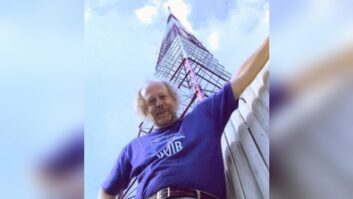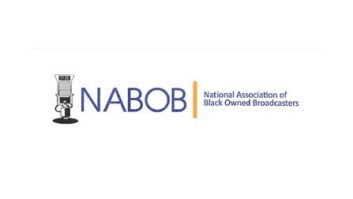As many readers know, non-commercial FM stations are separated not by mileage (as is the rule in the commercial part of the FM band) but by predicted interfering contours. For example, in our co-channel situation, my predicted 54 dBu contour can�t impinge on your predicted 40 dBu contour.
Showing the severity of the historical problem; the green shading is a predicted signal level of 40�54 dBu. It�s generally agreed that � absent interference � useable stereo reception can be had down to about 50 dBu, with useable mono down to about 35 dbu. Neither station had any hope beyond their 60 dBu, as the co-channel interference was too severe.

Unfortunately, due to the limitations of the prediction method, there are several situations similar to ours, namely: Two radio stations on the same frequency bordering a large metropolitan area, with both stations attempting to serve the metro � and both hampered by annoying mutual interference.
The above scenario is precisely what has historically confounded stations KCSN of Northridge, Calif. (on the northern end of the Los Angeles metro) and KSBR of Mission Viejo, Calif. (on the southern side), both broadcasting at 88.5 MHz. (SEE MAP)
Each station has adequately served their local areas for years with their own unique formats, but each has often complained to the other �I can hear your station in my station�s parking lot!�
The KCSN (highly directional) booster antenna.

To make matters worse, the interference is often exacerbated by the �coastal coax� � tropospheric ducting phenomenon that often impacts FM reception in southern California.
The only available technical solution to this impasse was to create a single frequency network: two stations on the same frequency with identical programming.
Not wanting to jump into this without a complete understanding of the potential gains or pitfalls, we engaged engineering consultant John Kean to thoroughly analyze the RF landscape.
John�s report was decisive and succinct: �The predicted results for the synchronous system are dramatic�adding first acceptable reception to millions of potential listeners located between the two stations.�
KCSN�s booster antenna from below.

GO!
In June 2017, the stations entered into a joint programming agreement, whereby both would carry the successful AAA format devised by Program Director Sky Daniels, thus creating this single frequency network.
In fact, KCSN has operated a booster in west Los Angeles for many years. Hence, with the addition of KSBR, this has become a three-station SFN. (The original two-station SFN for KCSN was previously covered in Radio. Read it here: http://tinyurl.com/ydb66dyt.)
Importantly, neither station was willing to consider changes to its existing antenna system or siting; the SFN needed to work �at the highest level that the state-of-the-art allows,� without any major changes to their existing antennas.
The technical travails of boosters and SFNs are well documented. Unless there is significant terrain obstruction to act as a shield between transmitters, the reception suffers from noise and distortion as one travels between the transmitter sites as a result of differing modulation levels and/or timing offsets at the individual transmitters. In this particular case, there is no significant terrain shielding; we needed to make this work as best we could without any natural RF barriers.
As luck would have it, several products were unveiled at the 2017 NAB Show that looked very promising.
We knew that the modulation levels at all three transmitters needed to be identical, as differences of less than 0.25 dB have been shown to raise the received noise floor dramatically. (This effect is discussed in Nautel�s webinar on SFNs, which can be viewed on YouTube at http://tinyurl.com/y98z6em2.)
We reasoned that if we could create the composite FM baseband signal once and then distribute it as an MPX (composite) over AES (192 kHz sample rate) data stream to all three sites, we�d have a good chance of maintaining precise modulation level control.
We were happy to discover at the Orban booth that their new flagship 8700i processor, with includes (as a standard feature) a �DMPX� digital composite output as an AES data stream of either 192 or 384 kHz sample rate. Using the AES data stream (which I will now refer to as AES-192), we were able to create the entire FM baseband signal once, and then to replicate it for all three transmitters via the STL system as planned.
In addition, the 8700i includes a built-in RDS encoder and has provisions for incorporating external SCA generators into the digital composite output. Plus, the 8700i also features a �REF� input, enabling us to lock its sample rate to our GPS-delivered 10 MHz time base. We were also intrigued by its new �Multipath Mitigator� phase correction scheme for reducing the effects of multipath distortion.
The bottom half of program distribution rack at KCSN, with Nautel HD Radio Exporter, GatesAir IP Link 200 (which receives content originated at KSBR and returns mix-minus to them), GatesAir IP Link MPXp primary STL, ESE ES-100 GPS receiver, Lucent switch and Nautel Importer.

WITH ONE BOX TICKED
We now needed an STL system to transport the AES-192 stream to all three sites, with the special provision that it needed to be transparent to the AES-192 stream from Orban 8700i (no re-clocking or sample-rate conversion) and it needed to deliver its output signal at precisely the same time at all three sites.
We were familiar with the GatesAir Synchrocast system, having used it successfully to time-align booster systems using T1 architecture. However, the T1 payload isn�t large enough to handle the AES-192 stream.
At the GatesAir booth, we zoomed in on the new Intraplex IP Link MPXp, an IP-based audio codec that delivers a single, bi-directional FM MPX composite signal, and found it was available with the Synchrocast option, specifically designed for SFNs.
With Synchrocast, the IP Link MPXp will deliver its digital MPX output with 1 micro-second accuracy to all three sites, using both 1 PPS and 10 MHz signals from either an optional internal or external GPS receiver. The IP Link can be configured for �transparent AES,� such that the AES-192 stream presented to its input is passed through without sample rate conversion or level change. If bandwidth conservation is important, one can chose lesser sample rates and/or bitrates to reduce the data rate of the digital AES stream. Additionally, the IP Link MPXp simultaneously outputs both digital MPX stream (on an XLR-3 connector) and an analog composite signal (on a BNC connector) enabling connection to a back-up transmitter, for example.
Simple one-line diagram of the 88.5 three-station SFN system.
Click to Enlarge

SECOND BOX TICKED
Lastly, we needed three new HD-capable transmitters that would accommodate a digital MPX input.
In this way, the AES-192 FM baseband signal created at the studio would migrate through the system unmolested; with the IP LINK configured for transparent AES mode, the digital composite signal created at the studio in the Optimod 8700i is never changed in any way.
Though several transmitter manufacturers offered AES-192 capability, we felt that Nautel was most appropriate, largely because of their pioneering work in enabling HD Radio broadcasts in SFNs � important because our SFN is committed to HD Radio. The Nautel user interface allows one to enable a micro-second resolution delay offset, vital in SFN�s for �moving� the inevitable interference area between transmitters.
Now, with three identical transmitters receiving identical AES composite signals, we were confident that we were as close to the �state-of-the-art� as we could get.
Top half of program distribution rack at KCSN, with Belar FMHD-1 monitor, Moseley 950 link to out-ofmarket translators, Orban Optimod 8700i and the former primary STL T1 frames.

NOW WE SET OFF TO BUILD THE NEW SFN
Aiming to achieve T1 reliability while distributing the composite signal over IP, we specifically wanted to avoid the Internet.
After much head-scratching, we alighted on AT&T�s switched Ethernet, a layer-2 based private Ethernet service with a service level agreement called Real Time. The Real Time SLA offers 5-millisecond one way latency, 3 ms jitter and a packet delivery rate of 99.995 percent. Not quite the �five nines� we enjoyed with T1 service, but pretty darn close, and the price was significantly less than a T1 (over the same distance).
The AT&T switched Ethernet is also convenient in that it allows us to put all of the IP codecs on the same layer-2 network. (Note: AT&T�s lead time can be significant; in our case, it was more than 75 days. Note, too, that the IP Link MPXp is completely capable of using the Internet as a connection medium and can accommodate multiple streams from differing ISP via the optional Dynamic Stream Splicing feature).
All told, it seems to us that the stars aligned perfectly, dropping the next generation of SFN-capable hardware into our laps just when it was needed.
Mike Worrall is Chief Engineer of KCSN, licensed to California State University, Northridge
MORE BACKGROUND
As part of the composition of this Facility Showcase, Radio magazine had a chance to ask Mike Worrall about the results of the SFN with the benefit of a little more time for analysis. Mike also described the methodology they intend to use to further align the system.
Mike Worrall

Radio:The first thing we want to ask is what has been the result so far? How long has the system been operating? And what kind of feedback are you getting from listeners?
Mike Worrall: Well let�s see, we went on Sept. 12. We�re talking on Oct. 6, so roughly three weeks. The results so far are pretty impressive, I think.
They�re all rather anecdotal. We have not yet done any kind of scientific analysis. I�ll put an asterisk on that and come back to it.
People are driving the freeways of southern California going �Wow, I can certainly hear you where I was never able to hear you before. Occasionally, it gets scratchy, but I�m able to ride through that, and get beyond the scratchy areas.�
I think so far the results are encouraging.
RM:You say there haven�t been any scientific measurements as of yet, but do you have something in mind?
MW: I do, and that is a result of a long conversation I had with John Kean � to whom I bow and genuflect to every time he�s on the phone.
I said, �John, I don�t have a lot of resources to make measurements, but I want to be more scientific about this than we�ve been able to sort of be so far.�
He said �OK, look, here�s what I do: Get yourself an HD Radio, and some sleep, and attack this at midnight on a Sunday night.�
For example, �Find a stretch of highway that has been reported to be problematic, and with a radio, an audio recorder and a quarter wave antenna mag mounted to the roof of your vehicle, find a half mile section of road that you can come back to, and back to, and back to, and back to, and if you�re able to log into your automation system, find a cut of music that you�re comfortable with that�s not wall-to-wall square waves, but has some dynamic range. Start that cut of music and start your vehicle and the recorder rolling with one transmitter on. Turn the other transmitter off.
�Come back, turn the other transmitter off, do the same stretch of highway with the same cut of music. Come back, turn both transmitters on. Do the same stretch of highway with the same cut of music.�
Now you�ve got a baseline. �Then you can begin to play with the delay from, for example KSBR�s transmitter, incrementing the delay, say in 25-microsecond chunks. Go back to the starting point and do it again. Just get yourself some audio samples that are identical across that same stretch of freeway.�
Now come back and analyze it. Say, �OK, well from square one what does it sound like with only one transmitter on? What does it sound like with the other transmitter on? What does it sound like with both on? Now, begin to understand what making delay adjustments do over that stretch of road.�
Now you�ve got an idea of where you are.
�Visit another stretch of road, and do the same thing. It�s gonna be like whack-a-mole in some scenarios where changing it in one location is going to mess it up in another location so this is not going to be a process that�s going to be consummated quickly and give you the end result in one stretch. You�re gonna have to make some effort here and spend multiple nights trying to understand what all the iterations are. Then, once you get that figured out, add the booster to the equation.�
I said, �John, I understand what you�re saying. It�s not going to be an easy fix, but I get the methodology that you�re suggesting that I employ to try to figure out how all these things interact.�
RM:How does HD Radio enter into the picture?
MW: Well, we are committed to HD, and we�ve been talking about this (meaning the two stations) for years. When we were talking to John Kean and Bert Goldman about it, they said � and this was earlier this year prior to the NAB Show � �Look, you pretty much want to forgo HD. It�s not gonna work. The current generation-four architecture is such that there�s no way to get the analog and the HD to work harmoniously. Until Xperi figures that out, you want to forgo HD.�
Well, fast forward to NAB 2017, where we were talking Philipp Schmid about his experimentation with KUSC, and their booster in Santa Clarita, and how he overcame Xperi�s gen-four architecture to enable HD to work in SFNs [Previously covered here: http://tinyurl.com/yc4fafmy.]
We said, �Hey, Philipp. We�re down on our knees. We�ve got this SFN coming up. We really want to do HD. Are you comfortable allowing us to use Nautel�s HD SFN system? Is it a final product? Is it a product that we can buy?�
He said, �No. It�s not going to be ready until fourth quarter of this year.�
We said, �Oh gosh, we really would like to do this coming out of the box, but can�t wait until the fourth quarter. Will you allow us to use the beta version, or whatever version it is that you now have available here at the convention to come on with us as soon as we can?�
He said, �Yeah, sure.�
He�s just a good guy and was willing to help us out.
So to answer your question: yes. HD is a major part of this, and KCSN and its booster are on in HD at the moment, but KSBR found that they had antenna bandwidth issues, and they tried to turn on HD, and the transmitter immediately pulled it back. They�re getting those antenna issues worked out, I think, as we speak. Tower crew was on site today, and hopefully by this time next week, the whole network will be up in HD.












